The Best of the Next Wave Affordable EVs
This year (2019) will be remembered as the year that battery electric vehicles became mainstream, with choices available from several manufacturers, offering vehicles that have become legitimate alternatives to traditional internal combustion engine vehicles. Compromises with price, range, charging and features are finally becoming a thing of the past. Prices and range are becoming competitive with conventional cars; public charging infrastructure continues to come online at a furious pace; and EV features are highlighting the unique advantages of owning and operating them.

The 2019 Kia Niro EV is a perfect example of this revolution. The Niro EV is a CUV (Compact Utility Vehicle) that offers a competitive price that starts at $38,500 and still qualifies for federal tax credits as well as state, local, utility and other rebates. These credits and rebates can lower the cost of the Niro to below to $30,000, depending on where you live. The Niro EV offers an EPA rated range of 239 miles or more under real-world driving. During our time with the Niro, it easily beat the EPA ratings with up to 261 miles of range. The Niro EV has industry-standard charging for use at home or on the road and has class-leading safety and convenience features that are on par with conventional luxury CUVs.
The Niro EV is part of a family of Kia CUVs that was designed with conventional, hybrid, and electric powertrains in mind. This strategy allows Kia to leverage the costs of manufacturing the Niro over a much broader base than just one vehicle and gives Kia the flexibility to match supply with demand. If our time with the Niro EV is any indication, the market is going to be strong for the EV version.
Sizing It Up
Overall, the Niro is about the same size as the Lexus UX, Toyota RAV4, the Chevy Bolt and its cousin the Hyundai Kona. It is shorter than the Nissan Leaf and has less cargo space, but its passenger space feels quite roomy despite it being a small crossover. It’s actually a five-door hatchback reimagined for the 21st-century compact crossover buyer.
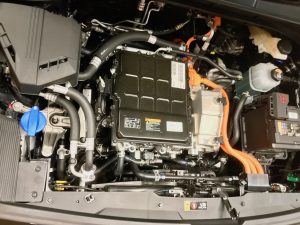
The Niro EV is powered by a 201-horsepower permanent magnet motor that has 290 pounds-feet of torque driven through a single-speed transmission powering the front wheels only. That gives the Niro EV plenty of grunt that gets it from 0-60 in 6.5 seconds. It wasn’t so long ago that sort of performance was considered to be supercar territory. With the Niro EV’s instant torque, it certainly can feel like a supercar.
The 2019 Kia Niro EV has three driving modes: Eco, Normal and Sport. Each has a set of adjustable settings including regeneration, air conditioning and heating, in addition to throttle responsiveness and steering-assist change, depending on the drive mode. In Eco mode, the top speed can be limited as well.
The Niro’s 64.0 kilowatt-hour lithium-ion liquid-cooled battery pack sits under the floor and offers an EPA range of 239 miles. The Niro is in the middle of the pack for mid-sized and priced EVs, bested only by its cousin the Hyundai Kona, but that is a moving target. Other mid-priced EV manufacturers competing with EVs are in the same general range of features and price. During our time with the Niro, it easily beat the EPA ratings with up to 261 miles of range.
Charging Options
The 2019 Kia Niro EV uses the emerging industry standard SAE Combo Charging System (CCS). The Niro is equipped with a 7.2-kilowatt (kW) onboard Level 2 (220v) charger for home or destination charging, and a 100-kW DC fast charger connection. The Niro allows the driver to set charging speeds, and what percentage to charge the battery from the multi-media display or a smartphone. The level of regeneration is also adjustable from paddle shifters or can be set to let the Niro decide what level of regeneration is best for the driving situation.

The 7.2-kW onboard charger can fully replenish the battery in about nine hours while the CCS connection can charge to about 80 percent in between 60 and 75 minutes, depending on the speed of the DCFC unit. Kia chose the CCS fast-charging standard, which is the fastest growing charging standard in the world. While Tesla’s proprietary charging standard has an early lead, the number of public CCS chargers coming online is quickly outnumbering the Tesla system. (The third fast-charging system is known as CHAdeMO, which is used by most Japanese automakers.)
Of course, if you have the time, the Niro’s battery can be recharged in about 59 hours if the supplied Level 1 (120v) EVSE is used.
All the Comforts You’d Expect
The Niro EV is well-equipped with creature comforts and technology features. There are two trim levels available–the EX, which has an MSRP of $38,500 and the EX Premium at $44,000. The Premium has all of the features of the EX, but adds a power sunroof, LED headlights and taillights, an 8.0-inch Touch Screen Infotainment screen and a Harman Kardon sound system with a subwoofer. A wireless phone charger, mood lighting, and leather upholstery round out the upgrades.
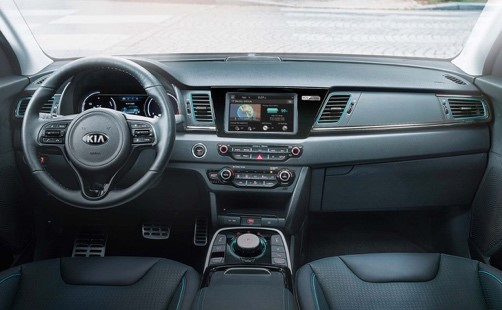
One option that is available on both trim levels of the Niro and is a must-have if you live in areas that have cooler seasons is the Cold Weather Package. This $1,080 package includes a battery heater, heated steering wheel and a cabin heat pump rather than a resistive electric heater. A heat pump can really improve range in cold weather and is recommended. Heated seats are standard on both trim levels.
Regardless of the trim, large 7.0- or 8.0-inch displays for the driver and infotainment provide excellent, clear, easy-to-see access to controls and information. Niro audio systems offer Android Auto, Apple CarPlay, Sirius XM, HD radio, Bluetooth and USB 3.0 inputs standard. The Niro’s audio systems have excellent sound and can be paired with just about any audio source. The Niro supports Kia’s latest UVO link LTE hotspot connectivity for smart devices.

The front and rear seats are comfortable, with eight- or 10-way seats designed for Americans in either cloth or leather, depending on the trim. The rear seating for some may be a bit tight, but generally, it is on par with the Niro EV’s competitors. The Niro’s interior is comfortable, but the rear seat foot room is a bit tight because of the high-back seat cushion. The Niro EV is noticeably quieter than its cousin, the Kona. The Niro has extra sound deadening and is fitted with Michelin Primacy MXV4 17-inch tires, which do a great job in isolating the cabin from road noise. Cargo capacity for the Niro EV is average for a CUV at 19.2 cu. ft., which is perfect for carrying a couple of bags of groceries, but not much more.
The Niro offers an extensive suite of active safety technology standard. This includes forward-collision avoidance with pedestrian detection, lane-departure and blind-spot assists, rear cross-traffic collision avoidance and automated high beams. Adaptive cruise control with stop-and-go capabilities is standard. With the adaptive cruise control, the Niro is a near Level 2 autonomous safety assist system like those from Tesla, Nissan, GM, Hyundai and others, and is very competent and on par with the current top-tier safety systems. The only nitpick about the safety systems is that they get your attention with a loud non-adjustable beeping that can be annoying.
A Summary—and a Challenge
The 2019 Kia Niro EV is a very competent, well-engineered CU-EV, but getting a closer look may be tricky, initially. Kia is being very conservative in making the Niro EV available. Initially, it is only available in 12 states—California, Connecticut, Georgia, Hawaii, Maryland, Massachusetts, New Jersey, New York, Oregon, Rhode Island, Texas, and Washington. Kia plans to offer the Niro EV in all 50 states eventually, and in the meantime, it is rumored that it can be special-ordered in areas where it is not initially available.

Pricing for the Niro EV ranges from $38,500 for the EX to $44,000 for the EX Premium. Options are few with just the cold weather package at $1,080, a Premium Launch Package at $1,000 and a wireless phone package for the EX at $200. Both trim levels have a $1,045 destination and handling charge.
The Niro EV does qualify for the full federal tax credit of $7,500, and any state, local, or utility rebates or credits available in your locale.
The 2019 Kia Niro EV is the current top benchmark for a well-equipped, reasonably-priced EV, along with its cousin, the Hyundai Kona EV. The Niro and Kona are very similar and share many of their parts, but at the end of the day, the winner is the Niro, which has more sophistication, roominess and refinement.
The Niro is the car that has become the standard that its competitors, like the Chevy Bolt, Nissan Leaf and even the Tesla Model 3 are being measured against.
But as the EV market continues to develop and mature, with new models continuing to be introduced, who knows who will be top-dog tomorrow?
Related Stories You Might Enjoy—the Long-Range EV Crowd
In order to give you the best perspective on the many vehicles available, Clean Fleet Report has a variety of contributors. When possible, we will offer you multiple perspectives on a given vehicle. This comes under SRO-Second Road Test Opinion. We hope you’ll enjoy these diverse views–some are just below—and let us know what you think in comments below or at publisher@cleanfleetreport.com.
Road Test: 2019 Kia Niro EV (Steve’s view)
Road Test: 2019 Chevrolet Bolt
Road Test: 2019 Hyundai Kona EV
Road Trip: 2019 Nissan Leaf Plus
News: Tesla Model 3—the Biggest Story of the Year
News: Tesla Model 3 $35,000 Version on Sale
Flash Drive: Tesla Model 3 Long Range
Make sure to opt-in to the Clean Fleet Report newsletter (top right of page) to be notified of all new stories and vehicle reviews.
Disclosure:
Clean Fleet Report is loaned free test vehicles from automakers to evaluate, typically for a week at a time. Our road tests are based on this one-week drive of a new vehicle. Because of this we don’t address issues such as long-term reliability or total cost of ownership. In addition, we are often invited to manufacturer events highlighting new vehicles or technology. As part of these events we may be offered free transportation, lodging or meals. We do our best to present our unvarnished evaluations of vehicles and news irrespective of these inducements.
Our focus is on vehicles that offer the best fuel economy in their class, which leads us to emphasize electric cars, plug-in hybrids, hybrids and diesels. We also feature those efficient gas-powered vehicles that are among the top mpg vehicles in their class. In addition, we aim to offer reviews and news on advanced technology and the alternative fuel vehicle market. We welcome any feedback from vehicle owners and are dedicated to providing a forum for alternative viewpoints. Please let us know your views at publisher@cleanfleetreport.com.


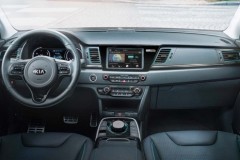

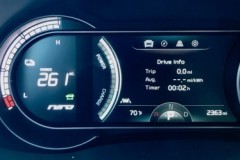
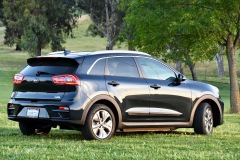

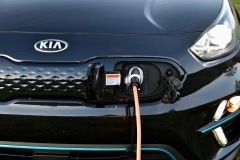
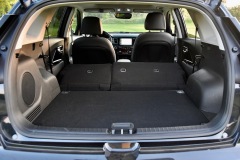
I think that “became mainstream with choices available” – is very dependent on country. Certainly not in Australia. In Australia there is limited infrastructure – enough for the very small number or BEVs or PHEVs being sold.
Nor the almost 1 billion people without electricity.
Hybrid is a good bridging technology, and will be for many years in most of the world.
@Alan Clarke,
Point taken. We sometimes forget that California is not the United States, much less the OECD world, even more less the developing world. However, even in China where electricity is intermittent at best the infrastructure issues are being addressed swiftly. Amazing what you can do in a dictatorship! We support all technologies, including advanced internal combustion engines, that help move the needle on climate change issues, particularly black carbon. –ed.
Yes – I was thinking more of Africa, India and other places.
But I do wonder about China – pushing for EVs, but as at the end of 2017, 64.7% of their actual power generated was from coal powered power stations – though some are getting “cleaner”.
I read that China has about 350,000,000 vehicles – and over a million EVs. I do wonder if they jumped too quickly from ICE to EV – without taking the intermediate hybrid step. Bearing in mind that a hybrid is about ½ the price of an equivalent EV – they could have had more impact on the pollution that way.
The “GreenVehicleGuide” – produced by the Australian Govt shows that a PRIUS is cleaner than any EV on the market – in Australia. China’s power is slightly greener, but not much.
@Alan Clarke,
There are a lot of complicated equations involved in this, but in CA at least the grid is quickly cleaning up (more than 40% renewables this year) and the logic of EVs involves not only GHG emissions–a global concern–but local criteria pollutants and toxics that are inherent in most petroleum combustion. We’re seeing the adoption of EVs driving more interest in renewable electricity, spurring home solar installation, for instance.
Of course this is the first world. Different measures are needed in the developing world. China’s a good example as many (most?) of the EVs there are not US/EU class vehicles, but still running without tailpipe emissions.
–ed.